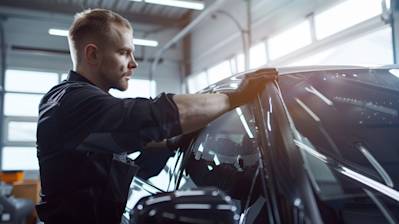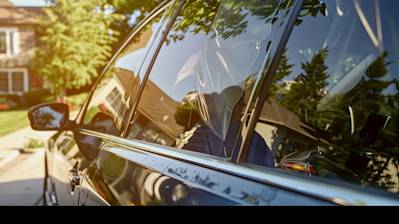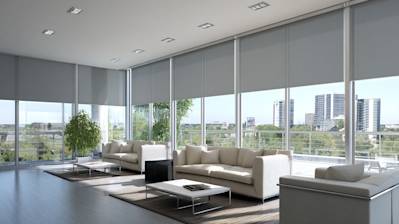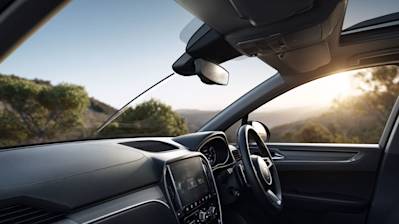Windows tints are not only a stylish addition to any vehicle but also provide benefits such as privacy and protection from sun rays. A 20% window tint is one popular choice among car owners, known for striking the perfect balance between style and functionality.
In this article, we'll delve deep into the world of 20% window tints to give you a comprehensive understanding of this popular tint choice.
What is a 20% Window Tint?
Window tints are measured in VLT (Visible Light Transmission) percentage, which is the amount of light allowed to pass through your car windows. A 20% window tint means that only 20% of light can penetrate the tinted window, making it a darker shade than tints with a higher VLT, such as 35% or 50%.
The Benefits of 20% Window Tints
A 20% tint comes with numerous benefits, which make it an attractive option. Here are a few:
- Enhanced Privacy: The tint is dark enough to prevent outsiders from seeing inside your vehicle, providing you with privacy.
- Glare Reduction: It significantly reduces glare caused by the sun or headlights, resulting in less strain on your eyes.
- UV Protection: 20% window tints block harmful UV rays, protecting your skin and car's interior from potential sun damage.
- Improved Aesthetics: It can add a sleek, sophisticated look to any vehicle, enhancing its overall aesthetics.
Using 20% Window Tint on Different Vehicle Windows
It's common to apply different tint shades to different vehicle windows. In many cases, the 20% window tint is applied to the back windows, while a lighter shade is applied to the front side windows. This can help meet legal restrictions on window tinting, while still offering privacy and sun protection in the majority of the vehicle's interior.
Understanding Legal Aspects of 20% Window Tints
The legality of window tints, including the 20% version, varies by location. Some states allow as low as 20% VLT on certain windows, while others prohibit veering below 35% or even 50%. It's essential to consult your local laws before deciding to go for a 20% window tint to ensure you abide by the restrictions laid out for your area.
Here are the general legal guidelines on 20% window tints across different states:
- Wide Acceptance: Many states, such as Georgia, Indiana, Maryland, and Michigan, allow a 20% window tint.
- Limited Acceptance: Some states, like Arizona, Connecticut, and Minnesota, allow 20% tints but limit them to specific windows.
- Limited or No Acceptance: Several states, including California, Illinois, and New York, have stringent laws regarding window tints and may allow only lighter shades or restrict them entirely.
How to Maintain 20% Window Tints
To ensure the longevity of your 20% window tint, certain maintenance practices should be followed.
- Appropriate Cleaning: Use ammonia-free cleaning solutions and soft cloth to clean tinted windows.
- Prevent Scratches: Avoid placing hard or sharp objects against the windows to prevent scratches.
- Professional Repair: If the tint film is damaged or peeling, it's advised to get it repaired by a professional rather than attempting a DIY fix.
Frequently Asked Questions about 20% Window Tint
How dark is a 20% window tint?
Given that a 20% window tint only allows 20% light penetration, it is comparatively darker than tinting options with higher percentages such as 35% or 50%. It delivers a smoky or charcoal-like appearance that considerably reduces the amount of outdoor light streaming into your automobile, providing a more private interior.
Will a 20% window tint significantly reduce heat inside my car?
Yes, indeed. A principal advantage of the 20% window tint is that it considerably reduces the amount of heat from the sun entering your car. This benefit is due to its low light transmittance value, which results in a cooler and more comfortable vehicle interior, especially during sweltering summer days.
Is a 20% window tint enough to prevent UV rays?
Thanks to the dark nature of the 20% window tint, it is highly effective at blocking dangerous UV rays. Its efficiency in UV protection correlates with its darkness level, making it an ideal choice if protection against sun damage is your primary concern.
Is a 20% window tint difficult to see through at night?
While 20% window tints enhance privacy and protect against UV rays, they can be slightly challenging to see through when the lighting conditions are poor, such as at night or during heavy rain. Therefore, when opting for this level of tint, it's important to consider the driving conditions common in your locale.
How long does it take to install a 20% window tint?
The duration for installing a 20% window tint varies, largely depending on the professional handling the task and the number of windows requiring the treatment. Typically, for an entire car, a skilled installer might need between 1 to 3 hours.
How can I clean windows with a 20% tint?
Cleaning a 20% window tint is pretty straightforward. You can use a soft microfiber cloth combined with a window cleaner that does not contain ammonia or vinegar, as these components might degrade the tint over time. It's also advisable to be gentle in pressure, to avoid peeling and scratches.
Is 20% window tint legal in all states?
Laws concerning window tinting vary widely by state. Some states don't allow tints darker than 50%, while others permit as low as 20% or even lower. Therefore, it's always good to review your state's specific window tint laws before deciding on the 20% window tint.
Pros of 20% Window Tint
Aesthetics
Enhances Your Vehicle's Appearance
20% window tint undoubtedly adds a sleek, upscale aesthetic to your car. This dark shade gives your automobile a sophisticated sense of mystery and privacy that lighter tints don't. The sharp contrast it creates with the car's paint job enhances the overall look, imparting a sense of style and personality to your car.
Heat Reduction
Keeps the Car's Interior Cool
A significant advantage of the 20% window tint is its effectiveness in blocking heat. It's known to block up to 80% of solar heat, which helps maintain a cool and comfortable temperature inside the vehicle. This feature is particularly useful in regions with high temperatures or during summer months when vehicles tend to get unbearably hot.
Protects Car's Interior
By reducing the amount of heat that penetrates into the car, the 20% window tint helps protect the vehicle's interior. Prolonged exposure to sunlight and heat can cause the car's dashboard, upholstery, and other plastic elements to crack or fade over time. The tint can effectively elongate the lifespan of these components.
UV Ray Protection
Blocks Harmful UV Rays
Exposure to UV rays can have detrimental health effects. The 20% window tint is known to block around 99% of harmful UV rays, meaning you and your passengers will be safer during travel. This prevention is particularly important if you're on the road often or make long journeys, as it minimizes the risk of skin-related health issues.
Preserves Skin Health
Blocking UV rays not only protects your health but also prevents premature skin aging. Sunlight exposure through car windows can lead to wrinkles, age spots, and other signs of skin aging. A 20% tint can safeguard your skin from these issues, keeping it younger and healthier looking.
Cons of 20% Window Tint
Visibility Issues
Compromised Nighttime Visibility
One notable drawback of the 20% window tint is that it can notably compromise visibility, especially at night or under low-light conditions. This decreased visibility can make night driving challenging and could potentially lead to accidents if the driver struggles to see pedestrians, cyclists, or other vehicles.
Hindered Rear View
Common complaints among drivers with a 20% window tint include difficulty seeing out of the rear window, particularly in nighttime or poor weather conditions. This problem can make activities like reversing or changing lanes more difficult and potentially hazardous.
Legal Restrictions
Legal Issues
In many regions, using tints that block more than a certain percentage of visible light is against the law. The exact percentages may vary, but in many areas, the 20% tint likely exceeds the legal limit. This aspect means that you could potentially face fines or be required to remove the tint.
Different Laws in Different States
In the US, window tint laws can vary significantly from one state to another. What is legal in one state may not be in another, causing potential problems if you travel out of state. This situation can make it challenging to choose an appropriate tint level that complies with local regulations.
Increased Costs
Cost and Time of Installation
Installing a 20% window tint requires a more significant investment in terms of cost and time than a lighter tint. This factor is because darker tints generally require more sophisticated technology to block heat and UV rays. Furthermore, the process of applying the tint onto the windows might require professional help, which adds to the overall cost.
Potential Replacement Costs
If your 20% window tint exceeds local legal limits, or if it deteriorates or gets damaged over time, you may need to replace it. This situation adds another round of costs plus the time and hassle of reinstalling. These costs are likely to be higher than if you'd opted for a lighter, potentially more legal, window tint initially.
With these pros and cons of 20% window tint, you can make an informed decision about whether this level of tinting is suitable for your automobile. While it offers significant benefits such as enhanced aesthetics, heat reduction, and UV ray protection, it also comes with some potential drawbacks, including visibility issues, legal restrictions, and increased costs.
Summary
So, there it is. If you're looking for the ultimate balance between privacy, style, and sunlight protection for your vehicle, a 20% window tint should be your go-to choice. Not only does it keep out about 80% of the sun's harmful UV rays, it also provides a sleek, cool look to any vehicle. But remember, while it's just dark enough to give you privacy, it's still clear enough to maintain your road safety.
Now, choosing a 20% window tint isn’t just a style statement, it's about comfort too. Imagine driving on a hot summer day without squinting or feeling like you're in a furnace. A quality tint can reduce glare and heat, making your journey much more enjoyable. Plus, with added privacy, you can keep those curious glances at bay. Just make sure it’s legal in your area before you go for it.
Lastly, I can’t stress enough how essential good quality is when it comes to 20% window tint. This percentage comes with its own set of benefits, from prolonged interior life due to less sun exposure to providing a clear, unobstructed view while driving. Therefore, while it's often more expensive, investing in a high-quality tint will surely pay off in the long run.
About A+ Window Tinting
A+ Window Tinting is your local expert in Roseville, CA for all things concerning window tinting. We're not just passionate about enhancing your car's aesthetic; we're committed to protecting you from harmful UV rays and achieving your comfort in those sunny California drives too. With top-quality materials and a highly skilled team, our service has been consistently voted as A++, exceeding our customers' expectations. Our authentic, hands-on approach means we cater to your individual needs directly, offering you personalized solutions, A+ service, and transparency at affordable rates. We're your friendly neighborhood window tinting company - ready to give you a cooler, stylish, and safer ride.








